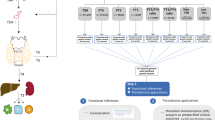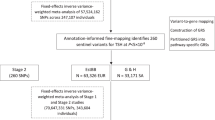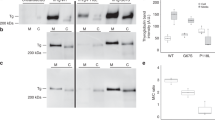Abstract
The inaugural issue of this journal, published in November 2005, included articles on thyroid cancer, type 2 diabetes mellitus, the metabolic syndrome, pituitary adenomas and obesity. 10 years later, we are still publishing articles on these topics (and many others). Although a great deal of progress has been made in our understanding of the pathogenesis, diagnosis and treatment of diseases of the endocrine system over the past 10 years, many challenges still remain. For this Viewpoint, we have asked five of our Advisory Board Members to comment on the progress and challenges from the past 10 years. They were also asked to offer their thoughts on where money should be spent going forward, and their predictions for what advances might be achieved in the next 10 years.
This is a preview of subscription content, access via your institution
Access options
Subscribe to this journal
Receive 12 print issues and online access
$209.00 per year
only $17.42 per issue
Buy this article
- Purchase on Springer Link
- Instant access to full article PDF
Prices may be subject to local taxes which are calculated during checkout
Similar content being viewed by others
References
Russell, S. J. et al. Outpatient glycemic control with a bionic pancreas in type 1 diabetes. N. Engl. J. Med. 371, 313–325 (2014).
Miller, K. M. et al. Current state of type 1 diabetes treatment in the US: updated data from the T1D Exchange clinic registry. Diabetes Care 38, 971–978 (2015).
The Diabetes Control and Complications Trial Research Group. The effect of intensive treatment of diabetes on the development and progression of long-term complications in insulin-dependent diabetes mellitus. N. Engl. J. Med. 329, 977–986 (1993).
Tooley, J. E., Waldron-Lynch, F. & Herold, K. C. New and future immunomodulatory therapy in type 1 diabetes. Trends Mol. Med. 18, 173–181 (2012).
Talchai, C., Xuan, S., Kitamura, T., DePinho, R. A. & Accili, D. Generation of functional insulin-producing cells in the gut by Foxo1 ablation. Nat. Genet. 44, 406–412 (2012).
Pagliuca, F. W. et al. Generation of functional human pancreatic β cells in vitro. Cell 159, 428–439 (2014).
Gloyn, A. L. et al. Activating mutations in the gene encoding the ATP-sensitive potassium-channel subunit Kir6.2 and permanent neonatal diabetes. N. Engl. J. Med. 350, 1838–1849 (2004).
Babenko, A. P. et al. Activating mutations in the ABCC8 gene in neonatal diabetes mellitus. N. Engl. J. Med. 355, 456–466 (2006).
Van den Berghe, G. et al. Intensive insulin therapy in the medical ICU. N. Engl. J. Med. 354, 449–461 (2006).
Russell, S. J. et al. Outpatient glycemic control with a bionic pancreas in type 1 diabetes. N. Engl. J. Med. 371, 313–325 (2014).
Pagliuca, F. W. et al. Generation of functional human pancreatic β cells in vitro. Cell 159, 428–439 (2014).
Cypess, A. M. et al. Identification and importance of brown adipose tissue in adult humans. N. Engl. J. Med. 360, 1509–1517 (2009).
Wu, J. et al. Beige adipocytes are a distinct type of thermogenic fat cell in mouse and human. Cell 150, 366–376 (2012).
Ridaura, V. K. et al. Gut microbiota from twins discordant for obesity modulate metabolism in mice. Science 341, 1241214 (2013).
Seminara, S. B. et al. The GPR54 gene as a regulator of puberty. N. Engl. J. Med. 349, 1614–1627 (2003).
Teles, M. G. et al. A GPR54-activating mutation in a patient with central precocious puberty. N. Engl. J. Med. 358, 709–715 (2008).
Raivio, T. et al. Reversal of idiopathic hypogonadotropic hypogonadism. N. Engl. J. Med. 357, 863–873 (2007).
Ong, K. K. et al. Genetic variation in LIN28B is associated with the timing of puberty. Nat. Genet. 41, 729–33 (2009).
Abreu, A. P. et al. Central precocious puberty caused by mutations in the imprinted gene MKRN3. N. Engl. J. Med. 368, 2467–2475 (2013).
Metherell, L. A. et al. Mutations in MRAP, encoding a new interacting partner of the ACTH receptor, cause familial glucocorticoid deficiency type 2. Nat. Genet. 37, 166–170 (2005).
Assie, G. et al. ARMC5 mutations in macronodular adrenal hyperplasia with Cushing's syndrome. N. Engl. J. Med. 369, 2105–2114 (2013).
Beuschlein, F. et al. Constitutive activation of PKA catalytic subunit in adrenal Cushing's syndrome. N. Engl. J. Med. 370, 1019–1028 (2014).
Rivkees, S. A. & Szarfman, A. Dissimilar hepatotoxicity profiles of propylthiouracil and methimazole in children. J. Clin. Endocrinol. Metab. 95, 3260–3267 (2010).
Cummings, S. R. et al. Denosumab for prevention of fractures in postmenopausal women with osteoporosis. N. Engl. J. Med. 361, 756–765 (2009).
McClung, M. R. et al. Romosozumab in postmenopausal women with low bone mineral density. N. Engl. J. Med. 370, 412–420 (2014).
Suga, H. et al. Self-formation of functional adenohypophysis in three-dimensional culture. Nature 480, 57–62 (2011).
Gleiberman, A. S. et al. Genetic approaches identify adult pituitary stem cells. Proc. Natl Acad. Sci. USA 105, 6332–6337 (2008).
Rizzoti, K., Akiyama, H. & Lovell-Badge, R. Mobilized adult pituitary stem cells contribute to endocrine regeneration in response to physiological demand. Cell Stem Cell 13, 419–432 (2013).
Budry, L. et al. Related pituitary cell lineages develop into interdigitated 3D cell networks. Proc. Natl Acad. Sci. USA 108, 12515–12520 (2011).
Hosoyama, T. et al. A postnatal Pax7 progenitor gives rise to pituitary adenomas. Genes Cancer 1, 388–402 (2010).
Chesnokova, V. et al. p21(Cip1) restrains pituitary tumor growth. Proc. Natl Acad. Sci. USA 105, 17498–17503 (2008).
Fukuoka, H. et al. EGFR as a therapeutic target for human, canine, and mouse ACTH-secreting pituitary adenomas. J. Clin. Invest. 121, 4712–4721 (2011).
Reincke, M. et al. Mutations in the deubiquitinase gene USP8 cause Cushing's disease. Nat. Genet. 47, 31–38 (2015).
Vierimaa, O. et al. Pituitary adenoma predisposition caused by germline mutations in the AIP gene. Science 312, 1228–1230 (2006).
Daly, A. F., Trivellin, G. & Stratakis, C. A. Gigantism, acromegaly, and GPR101 mutations. N. Engl. J. Med. 372, 1265 (2015).
Colao, A. et al. A 12-month phase 3 study of pasireotide in Cushing's disease. N. Engl. J. Med. 366, 914–924 (2012).
Neggers, S. J. et al. Long-term efficacy and safety of pegvisomant in combination with long-acting somatostatin analogs in acromegaly. J. Clin. Endocrinol. Metab. 99, 3644–3652 (2014).
Cuevas-Ramos, D. et al. A structural and functional acromegaly classification. J. Clin. Endocrinol. Metab. 100, 122–131 (2015).
International Diabetes Federation. IDF Diabetes Atlas Sixth Edition [online], (2014).
Diabetes Control and Complications Trial Research Group. The effect of intensive treatment of diabetes on the development and progression of long-term complications in insulin-dependent diabetes mellitus. N. Engl. J. Med. 329, 977–986 (1993).
UK Prospective Diabetes Study (UKPDS) Group. Intensive blood-glucose control with sulphonylureas or insulin compared with conventional treatment and risk of complications in patients with type 2 diabetes (UKPDS 33). Lancet 352, 837–853 (1998).
Gerstein, H. C. et al. Action to Control Cardiovascular Risk in Diabetes Study Group Effects of intensive glucose lowering in type 2 diabetes. N. Engl. J. Med. 358, 2545–2559 (2008).
Yudkin, J. S., Richter, B. & Gale, E. A. Intensified glucose lowering in type 2 diabetes: time for a reappraisal. Diabetologia 53, 2079–2085 (2010).
Raz, I. et al. Personalized management of hyperglycemia in type 2 diabetes: reflections from a Diabetes Care Editors' Expert Forum. Diabetes Care 36, 1779–1788 (2013).
Haugen, B. R. et al. 2015 American Thyroid Association management guidelines for adult patients with thyroid nodules and differentiated thyroid cancer. Thyroid (in press).
Cancer Genome Atlas Research Network. Integrated genomic characterization of papillary thyroid carcinoma. Cell 159, 676–690 (2014).
Reed, J. C. & Herold, K. C. Thinking bedside at the bench: the NOD mouse model of T1DM. Nat. Rev. Endocrinol. 11, 308–314 (2015).
Bero, L. Industry sponsorship and research outcome. A Cochrane Review. JAMA Intern. Med. 173, 580–581 (2013).
Ito, Y., Nikiforov, Y., Schlumberger, M. & Vigneri, R. Increasing incidence of thyroid cancer: controversies explored. Nat. Rev. Endocrinol. 9, 178–184 (2013).
Brassard, M. et al. Long-term follow-up of patients with papillary and follicular thyroid cancer: a prospective study on 715 patients. J. Clin. Endocrinol. Metab. 96, 1352–1359 (2011).
Xing, M. M., Haugen, B. & Schlumberger, M. Progress in molecular-based management of differentiated thyroid cancer. Lancet 381, 1058–1069 (2013).
Durante, C. et al. Long-term outcome of 444 patients with distant metastases from papillary and follicular thyroid carcinoma: benefits and limits of radioiodine therapy. J. Clin. Endocrinol. Metab. 91, 2892–2899 (2006).
Schlumberger, M. et al. Definition and management of radioactive iodine-refractory differentiated thyroid cancer: recommendations by an international expert panel. Lancet Diabetes Endocrinol. 2, 356–358 (2014).
Brose, M. S. et al. A randomized trial of sorafenib for 131I-refractory differentiated thyroid cancer. Lancet 384, 319–328 (2014).
Schlumberger, M. et al. Lenvatinib versus placebo in radioiodine-refractory thyroid cancer. N. Engl. J. Med. 372, 621–630 (2015).
Herold, K., Vignali, D. A., Cooke, A. & Bluestone, J. Type 1 diabetes: Translating mechanistic observations into effective clinical outcomes. Nat. Rev. Immunol. 13, 243–256 (2013).
Gadelha, M. R. et al. Pasireotide versus continued treatment with octreotide or lanreotide in patients with inadequately controlled acromegaly (PAOLA): a randomised, phase 3 trial. Lancet Diabetes Endocrinol. 2, 875–884 (2014).
American Diabetes Association. Economic costs of diabetes in the US in 2012. Diabetes Care 36, 1033–1046 (2013).
Ali, M. K. et al. Achievement of goals in U. S. diabetes care, 1999–2010. N. Engl. J. Med. 368, 1613–1624 (2013).
Mallick, U. et al. Ablation with low-dose radioiodine and thyrotropin alfa in thyroid cancer. N. Engl. J. Med. 366, 1674–1685 (2012).
Schlumberger, M. et al. Strategies of radioiodine ablation in low-risk thyroid cancer patients. N. Engl. J. Med. 366, 1663–1673 (2012).
Ho, A. L. et al. Selumetinib-enhanced radioiodine uptake in advanced thyroid cancer. N. Engl. J. Med. 368, 623–632 (2013).
Mohan, J. F., Petzold, S. J. & Unanue, E. R. Register shifting of an insulin peptide-MHC complex allows diabetogenic T cells to escape thymic deletion. J. Exp. Med. 208, 2375–2383 (2011).
Stadinski, B. D. et al. Diabetogenic T cells recognize insulin bound to IAg7 in an unexpected, weakly binding register. Proc. Natl Acad. Sci. USA 107, 10978–10983 (2010).
Herold, K. C. et al. β cell death and dysfunction during type 1 diabetes development in at-risk individuals. J. Clin. Invest. 125, 1163–1173 (2015).
Mallone, R. et al. Immunology of Diabetes Society T-Cell Workshop: HLA class I tetramer-directed epitope validation initiative T-Cell Workshop Report-HLA Class I Tetramer Validation Initiative. Diabetes Metab. Res. Rev. 27, 720–726 (2011).
Cariboni A. et al. Dysfunctional SEMA3E signaling underlies gonadotropin-releasing hormone neuron deficiency in Kallmann syndrome. J. Clin. Invest. 125, 2413–2428 (2015).
Author information
Authors and Affiliations
Contributions
All authors contributed to all aspects of this manuscript.
Corresponding authors
Ethics declarations
Competing interests
J.A.M. is named as an inventor on two patent applications related to obesity. S.M. has been a scientific consultant for Chiasma and Isis; has received research grant support from Ipsen and Pfizer; and has been an education consultant for Novartis. M.S. has received research support and honoraria and has been on advisory boards for AstraZeneca, Bayer, Eisai and Exelixis-Sobi. K.C.H. and M.P. declare no competing interests.
Rights and permissions
About this article
Cite this article
Herold, K., Majzoub, J., Melmed, S. et al. Endocrinology research—reflecting on the past decade and looking to the next. Nat Rev Endocrinol 11, 672–680 (2015). https://doi.org/10.1038/nrendo.2015.164
Published:
Issue Date:
DOI: https://doi.org/10.1038/nrendo.2015.164



